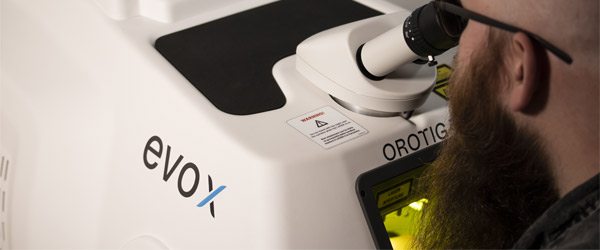What is laser welding?
In laser welding, an amplified beam of light is used to join two or more pieces of metal together. The laser beam in this type of welding provides a focused heat source that melts the metal, creating a weld pool that solidifies to form a strong bond.
The operator of a laser welder emits a beam of light that they control, adjust and concentrate. In a similar way to the flame of a soldering torch being regulated by a jeweller. In comparison to soldering, laser welding is cleaner, faster and more cost-effective for many repair and manufacturing applications.
Can all metals be welded with a laser welder?
Yes, all precious metals can be laser welded, this includes:
– all base metals
– gold
– sterling silver
– titanium
– palladium
– platinum
Platinum may be known as being one of the most difficult metals to work with but it is actually one of the easiest to laser weld. You can also weld different metals together, such as gold to platinum and sterling silver to gold.
Is it difficult to operate a laser welding machine?
No, many principles that relate to torch welding, also relate to laser welding. The main thing is knowing what makes the metal move. It does help that the machines that are currently on the market are user-friendly and with training, practice and patience you can become a skilled welder. Those that use laser welders note that it takes between 10 to 20 hours to become proficient in using a laser welder and we can offer training and support with any of our welders, to help you on your journey.


How can laser welders be used in jewellery manufacturing?
Casting
The porosity of the metal can be a common problem in the casting and manufacturing process, even when using high-tech casting machines. A jewellery laser welder can repair and correct porosity that’s discovered in raw casting or in a finished, polished, stone-set piece of jewellery.
The process of repairing cast jewellery pieces with a laser welding machine is easy and quick. As it eliminates the time involved in removing set stones. There is no need to recast, so time and expense are no longer an issue and yet the cast productivity has increased.
Assembly
There is no solder involved, which means there will be substantial savings. It also prevents the “halo” effect created when using a solder. Again the time involved is also decreased as the pieces can be quickly tacked together, in comparison to traditional methods.
A near-perfect and high quality piece of jewellery is easier to create by jewellery manufacturers when using laser welding machines. Production can be boosted and errors reduced, as manufacturers that use laser welding machines find new uses for them.
Can laser welder be used in jewellery retail stores?
Antique Jewellery Restoration & Repairs
Usually, antique jewellery can take many hours to prepare and set up, due to the removal of stones and working with heat sensitive materials. Not having to remove these stones and materials means that applications such as sizing and filigree repair become easier and faster. In comparison to traditional torch methods, the applications are not only easy to do but the reduction in set-up times and elimination of assembly time also make it possible to repair or restore antique jewellery fast.
Repairs to Spring Mechanisms
As the heat zone is small in a jewellery laser welder and the beam it makes is so precise, it will not affect the spring mechanism. Thus making it possible to weld lobster clasps, spring rings, euro-wires and most watch repairs.
Find out more about using jewellery laser welders by heading into our store for a demo or perusing our laser welder items on our site.


Cooksongold

